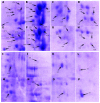Altered profiles of nuclear matrix proteins during the differentiation of human gastric mucous adenocarcinoma MGc80-3 cells
- PMID: 16094700
- PMCID: PMC4615401
- DOI: 10.3748/wjg.v11.i30.4628
Altered profiles of nuclear matrix proteins during the differentiation of human gastric mucous adenocarcinoma MGc80-3 cells
Abstract
Aim: To find and identify specific nuclear matrix proteins associated with proliferation and differentiation of carcinoma cells, which will be potential markers for cancer diagnosis and targets in cancer therapy.
Methods: Nuclear matrix proteins were selectively extracted from MGc80-3 cells treated with or without hexamethylamine bisacetamide (HMBA), and subjected to 2-D gel electrophoresis. The resulted protein patterns were analyzed by Melanie software. Spots of nuclear matrix proteins differentially expressed were excised and subjected to in situ digestion with trypsin. Peptide masses were obtained by matrix-assisted laser-desorption/ionization time of flight mass spectrometry (MALDI-TOF-MS) analysis and submitted for database searching using Mascot tool.
Results: The MGc80-3 cells were induced into differentiation by HMBA. There were 22 protein spots which changed remarkably in the nuclear matrix, from differentiation of MGc80-3 cells compared to control. Eleven of which were identified. Seven proteins--actin, prohibitin, porin 31HL, heterogeneous nuclear ribonucleoprotein A2/B1, vimentin, ATP synthase, and heat shock protein 60 were downregulated, whereas three proteins--heat shock protein gp96, heat shock protein 90-beta, and valosin-containing protein were upregulated, and the oxygen-regulated protein was only found in the differentiated MGc80-3 cells.
Conclusion: The induced differentiation of carcinoma cells is accompanied by the changes of nuclear matrix proteins. Further characterization of those proteins will show the mechanism of cellular proliferation and differentiation, as well as cancer differentiation.
Figures



Similar articles
-
Aberrant expression of nuclear matrix proteins during HMBA-induced differentiation of gastric cancer cells.World J Gastroenterol. 2010 May 7;16(17):2176-82. doi: 10.3748/wjg.v16.i17.2176. World J Gastroenterol. 2010. PMID: 20440860 Free PMC article.
-
Changes of nuclear matrix proteins following the differentiation of human osteosarcoma MG-63 cells.Genomics Proteomics Bioinformatics. 2006 Feb;4(1):10-7. doi: 10.1016/S1672-0229(06)60011-9. Genomics Proteomics Bioinformatics. 2006. PMID: 16689697 Free PMC article.
-
Alteration of nuclear matrix-intermediate filament system and differential expression of nuclear matrix proteins during human hepatocarcinoma cell differentiation.World J Gastroenterol. 2007 May 28;13(20):2791-7. doi: 10.3748/wjg.v13.i20.2791. World J Gastroenterol. 2007. PMID: 17569113 Free PMC article.
-
[Changes of nuclear matrix proteins during differentiation of human osteosarcoma MG-63 cells induced by HMBA].Fen Zi Xi Bao Sheng Wu Xue Bao. 2006 Apr;39(2):169-76. Fen Zi Xi Bao Sheng Wu Xue Bao. 2006. PMID: 16944589 Chinese.
-
[Expression and localization of hnRNP A2/B1 during differentiation of human osteosarcoma MG-63 cells induced by HMBA].Ai Zheng. 2008 Jul;27(7):677-84. Ai Zheng. 2008. PMID: 18606058 Chinese.
Cited by
-
Vimentin binds to G-quadruplex repeats found at telomeres and gene promoters.Nucleic Acids Res. 2022 Feb 22;50(3):1370-1381. doi: 10.1093/nar/gkab1274. Nucleic Acids Res. 2022. PMID: 35100428 Free PMC article.
-
Aberrant expression of nuclear matrix proteins during HMBA-induced differentiation of gastric cancer cells.World J Gastroenterol. 2010 May 7;16(17):2176-82. doi: 10.3748/wjg.v16.i17.2176. World J Gastroenterol. 2010. PMID: 20440860 Free PMC article.
-
Positional and expressive alteration of prohibitin during the induced differentiation of human hepatocarcinoma SMMC-7721 cells.World J Gastroenterol. 2008 Aug 28;14(32):5008-14. doi: 10.3748/wjg.14.5008. World J Gastroenterol. 2008. PMID: 18763282 Free PMC article.
-
β-catenin induces expression of prohibitin gene in acute leukemic cells.Oncol Rep. 2017 Jun;37(6):3201-3208. doi: 10.3892/or.2017.5599. Epub 2017 Apr 25. Oncol Rep. 2017. PMID: 28440457 Free PMC article.
-
Vimentin Is at the Heart of Epithelial Mesenchymal Transition (EMT) Mediated Metastasis.Cancers (Basel). 2021 Oct 5;13(19):4985. doi: 10.3390/cancers13194985. Cancers (Basel). 2021. PMID: 34638469 Free PMC article. Review.
References
-
- Berezney R, Mortillaro MJ, Ma H, Wei X, Samarabandu J. The nuclear matrix: a structural milieu for genomic function. Int Rev Cytol. 1995;162A:1–65. - PubMed
-
- S'iakste NI, S'iakste TG. Transcription factors and the nuclear matrix. Mol Biol (Mosk) 2001;35:739–749. - PubMed
-
- Gooden MD, Vernon RB, Bassuk JA, Sage EH. Cell cycle-dependent nuclear location of the matricellular protein SPARC: association with the nuclear matrix. J Cell Biochem. 1999;74:152–167. - PubMed
-
- Khanuja PS, Lehr JE, Soule HD, Gehani SK, Noto AC, Choudhury S, Chen R, Pienta KJ. Nuclear matrix proteins in normal and breast cancer cells. Cancer Res. 1993;53:3394–3398. - PubMed
Publication types
MeSH terms
Substances
LinkOut - more resources
Full Text Sources
Medical
Research Materials

